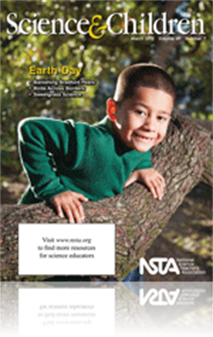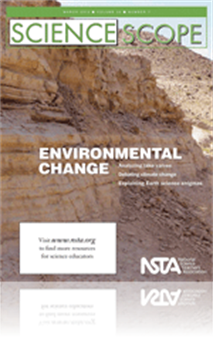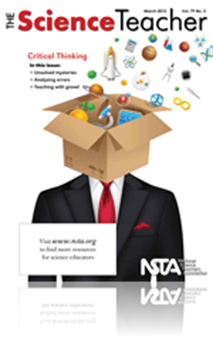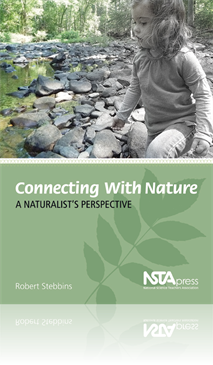All Resources
Journal Article
Editor's Note: Earth Day—Then and Now
Science and Children’s editor shares thoughts regarding the current issue....
Journal Article
Methods and Strategies: From Landfills to Robots
Third-grade students work like engineers as they learn about recycling and reusing materials, encouraging change at home....
Journal Article
Scope on the Skies: March Mars Madness
This column focuses on astronomy throughout the year. This month’s issue discusses myths surrounding Mars and how it appears in the sky when it reaches opposition....
Journal Article
Editorial: Every Good Being Deserves Favor
The Journal of College Science Teaching’s editor shares thoughts regarding the current issue....
Journal Article
Guest Editorial: Reflections on a Classroom Managed Through Inquiry: Moving Past "Nondiscipline"
An opinion piece about how class management using inquiry engages students in meaningful science activities and effectively reduces discipline problems....
Journal Article
The Green Room: Earth Day 2012
This column focuses on making your teaching more environmentally friendly. This month’s issue talks about how to celebrate Earth Day at school....
Journal Article
The Early Years: Learning by Nature
This column discusses resources and science topics related to students in grades preK to 2. This month’s issue discusses getting children comfortable with nature by facilitating positive outdoor experiences....
Journal Article
Students gain a sense of place during an integrated unit featuring a lowcountry plant. Place-based education can be used for the study of any subject related to the local community and culture; however, the authors concentrated mostly on the science ...
Journal Article
Idea Bank: 13 Tips for Writing in the Science Classroom
The Idea Bank provides tips and techniques for creative teaching, in about 1,000 words. This month’s Idea Bank shares 13 methods to incorporate writing into high school biology and chemistry classrooms....
Journal Article
This column focuses on issues related to environmentally friendly and sustainable science. This month’s issue discusses the pros and cons of hydraulic fracturing used in gas production....
Journal Article
Reconstructing Environmental Change Using Lake Varves as a Climate Proxy
This article describes an investigative activity in which eighth-grade students reconstructed past environmental change in the New England area using data from lake varves in central Vermont to examine evidence of climate change....
Journal Article
This study examines preservice elementary teachers' ability to generate a testable question using data made accessible online through the Great Lakes Environmental Research Laboratory and Michigan Sea Grant....
Journal Article
Gravel can be an effective, inexpensive, and abundant resource that helps students think critically during several interdisciplinary science activities and investigations....
Journal Article
A recaptured natural area on school grounds becomes an outdoor classroom where learning opportunities abound. ...
Journal Article
Teachers created an after-school club called The Green Team and implemented an instructional strategy know as service-learning to teach environmental science. This article describes the transformation that occurred over a three-year period and illust...
Journal Article
Save the Boulders Beach Penguins
Third-grade students practice engineering skills as they design dwellings for model penguins....
Journal Article
Career of the Month: Energy Engineer
This column shares interviews with professionals using science in the workplace. This month’s issue provides information about being an energy engineer....
Journal Article
Science 2.0: Creative, Inspiring, and Jaw-Dropping Videos
This column shares web tools that support learning. This month’s issue shares information about the Technology, Entertainment, and Design website....
Journal Article
Outstanding Science Trade Books for Students K–12: Books Published in 2011
NSTA and the Children's Book Council identify the best science trade books that were published in 2011....
Journal Article
Teaching Through Trade Books: Teaching the Three R's: Reduce, Reuse, Recycle
This column includes activities inspired by children’s literature. This month’s lessons focus on the journeys of trash items and how students can affect their paths....
Journal Article
In this article, the authors look in-depth at scientific practice number 2—developing, evaluating, and revising scientific models to explain and predict phenomena—and what it means for classroom teaching. ...
Journal Article
This article offers instructional strategies that teach students to think critically....
Journal Article
Lessons Learned From a Summer Preparatory Program on Foundations in Physics and Calculus
This article presents details about a summer instructional program created by physics graduate students who sought a chance to help students from the local community and to gain greater experience teaching science and math. The students initiated, de...
Journal Article
This article explores ways that people impact ecological systems and how those systems can influence our daily lives. Students use newspaper articles and case studies of scientific research to link daily human life and disrupted ecological function....
Journal Article
This study compares a cookbook-type laboratory course to a research-based undergraduate biology laboratory course at a Research 1 institution. The results indicate that students in the research-based lab had more positive attitudes toward authentic r...
Journal Article
The Sixth Great Mass Extinction
This article explains the first five great mass extinctions, the current great mass extinction, and the human activities and rates of species extinction associated with the current extinction....
Journal Article
Factors Related to Students' Learning of Biomechanics Concepts
The purpose of the study described in this article was to replicate and expand a previous study to identify the factors that affect students' learning of biomechanical concepts....
Journal Article
Outstanding Science Trade Books for Students K–12: Books published in 2011
NSTA and the Children's Book Council identify the best science trade books published in 2011....
Journal Article
This study examines gender differences in the motivation to embark on graduate careers in physics and chemistry and whether this motivation can predict select future success outcomes for physical scientists....
Journal Article
Editor's Corner: Thinking Critically
The Science Teacher’s editor shares thoughts on the current issue....
Journal Article
This article describes a new instructional model called Argument-Driven Inquiry (ADI), which is designed to promote student engagement in processes of investigation design and scientific argumentation. The ADI instructional model is compared with a m...
Journal Article
Generating Arguments About Climate Change
Students participate in a unit on global climate change by engaging in the process of scientific argumentation. The lessons presented in this article were created using the generate-an-argument model to help students understand climate change science...
Book Chapter
Evolution:Nature’s Driving Force for Change
To be ecologically literate, students need to understand the process of natural selection. It is essential to an understanding of evolution. Groundwork for understanding natural selection can begin in the upper elementary grades. Local populations of...







